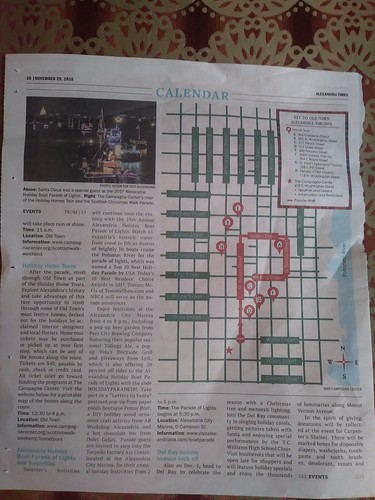Events as drivers of activity for traditional commercial districts | Holiday edition
The Guardian has a story, "Why switching on Christmas lights is now a big turn-off: In towns across the country, the big event is now too much hassle to run," about a town in the UK where the merchants have stopped holding an annual Christmas/Holiday lighting event because of complaints, the time required to accomplish it, and the sense that the event doesn't help draw customers.
The latter point is the most important. You have to be hard headed about events in terms of whether or not they help bring business. After all, the original "Summer sidewalk sales" weren't "placemaking" per se, they were price discount based sales aimed at driving business during otherwise slow periods, and a way to get rid of slow moving inventory.
I have some experience with this in some commercial districts in DC. One of the downsides of the "Main Street" approach, which adds non-merchants to the organization mix in a commercial district revitalization effort, is that they might not be so clued into events as money makers vs. placemaking.
On the other hand, merchants tend to not be great or creative at thinking beyond the confines of their stores--for years, I keep pushing against one Eastern Market vendor's desire for a "customer appreciation event" because "customer appreciation" isn't enough in and of itself to draw customers.
WRT the point in Aldeburgh, UK, where the merchants don't think that the events are drawing customers:
In theory, a Christmas lights event should tempt people to the high street, but retailers say they see a dip in sales during a big event.There are three points.
Is the event the right event? First, you have to be sure the event will draw customers. If it's just nice to do but you don't see an economic payoff, then it's either the wrong event, or the wrong event for the commercial district revitalization group to organize and instead should be sponsored by another type of group.
Does the merchant plan the right responses to leverage the event? But second, and a point too often ignored, the merchants and vendors need to plan for creative ways to leverage the event for sales, to bring people into the stores. Too often, they think that means discounts, and discounts cost money in lost revenue, unless they result in significantly greater revenues, help move otherwise slow moving inventory, etc.
This kind of creative planning doesn't usually happen. I've argued for years that commercial district revitalization organizations need to do store-by-store "mini-charrettes" with merchants to help them figure out ways to leverage events.
Creating a program instead of a single event. The third thing is to create a "program of events" rather than a one-off event. That makes events like the Holiday Lighting an "anchor event" around which you can build a more wide ranging program, which extends the impact and provides multiple opportunities for drawing in customers--especially if the schedule aims to provide an array of programs targeting a variety of customer segments.
In community organizing generally, anything you do should always be focused on "next steps," in how you stage an event to get new customers or members or volunteers, and to have your next event already scheduled, so that you can further draw them to that event and tie them more closely to your organization/commercial district.
This ad for the holiday event schedule is for the Del Ray commercial district in Alexandria, Virginia and was published in the Alexandria Times.

One of the anchor events in the holiday programming schedule in Old Town Alexandria is a Holiday House Tour, which was yesterday.

Many organizations as part of their program of marketing materials will include a brochure that lists the commuhity's annual and/or seasonal event calendar. Of course, the annual program should also be on a webpage, such as this for Old Town Winchester, and in a monthly calendar, for which Main Street Takoma (Park) does a particularly good job.
Main Street Takoma Park puts their event schedule on banners, which are are placed in prominent locations in the Old Takoma and Takoma Junction commercial districts.

Constructing a year round events calendar. A way to think about creating your program schedule by year, season, big events elsewhere in your city, and thematic specific to your place/commercial district. This concept was produced Balmori & Associates, in responding to the opportunity of the forthcoming 11th Street Bridge Park in DC.

Programming planning framework for parks, public squares, commercial districts, Balmori & Associates.
Why you need commercial district support organizations. One of the other complaints of the merchants in Aldeburgh is the time required to organize a big event, and the funding required, time and money which takes away from other priorities. From the article:
Arranging the events ate up 200 hours of his time, Mabey estimates. This involved finding a stage, organising lights, shutting the high street and finding personalities such as Lenny Henry or Emma Freud to switch them on – as well as raising about £22,000.That's why you need overarching organization support for commercial district revitalization planning and programming more generally.
It doesn't necessarily have to be a business improvement district or a Main Street organization. There are different ways to provide some level of support. But it needs to be provided in a structured and supportive way. You'd rather have the merchants focus most of their time on making their business more successful, not raising money and tracking down stages, lighting, and other logistical requirements.
Labels: commercial district revitalization planning, daypart planning, special events and programming



0 Comments:
Post a Comment
<< Home